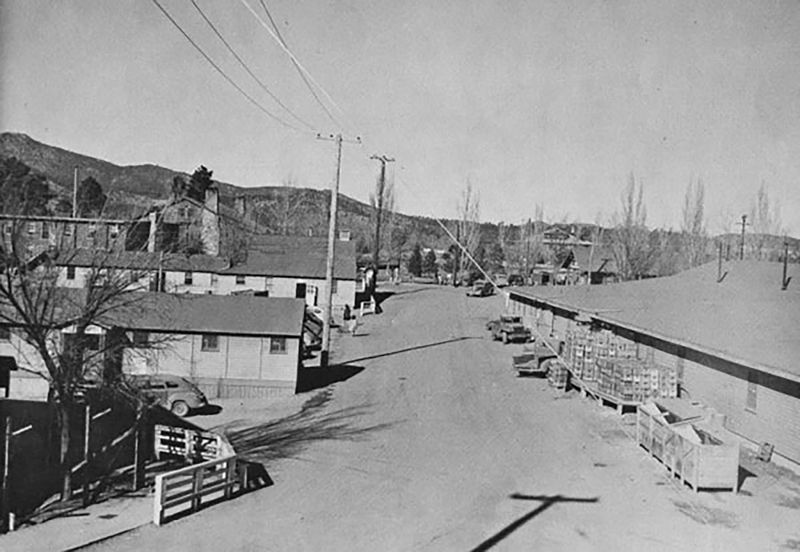‘Oppenheimer’ and the story behind those who lost their land to the lab
2023.07.28 18:04
2/2

© Reuters. The town of Los Alamos, New Mexico with Fuller Lodge and the “Big House” dormitories is seen in an undated photograph. Department of Energy/Handout via REUTERS.
2/2
By Andrew Hay
(Reuters) – In the movie “Oppenheimer” the eponymous character played by Cillian Murphy says the proposed site for a secret atomic weapons lab in northern New Mexico has only a boys’ school and Indians performing burial rites.
But there were homesteaders living on that land.
In 1942, the U.S. Army gave 32 Hispano families on the Pajarito Plateau 48 hours to leave their homes and land, in some cases at gunpoint, to build the lab that would create the world’s first atomic bombs, according to relatives of those removed and a former lab employee.
Homes were bulldozed, livestock shot or let loose, and families given little or no compensation, according to Loyda Martinez, 67, who worked as a computer scientist for 32 years at Los Alamos National Laboratory (NYSE:) (LANL) and cited accounts from evicted ranching and farming families who are her neighbors in the Espanola Valley.
A National Nuclear Security Administration spokesperson said Hispanic farmers were compensated at a significantly lower rate than white property owners but the agency was not aware of homes being destroyed and animals killed or abandoned. The agency did not address whether homesteaders were forcefully removed.
Martinez has spent decades campaigning for the evicted homesteaders and the rights of Hispano, Native, women and other lab employees and has won two class action suits relating to equal pay and treatment for them.
“These were Hispanic American homesteaders which perhaps explains why this dark episode in American history is so ignored,” she said.
Christopher Nolan’s blockbuster “Oppenheimer” has stirred up northern New Mexico’s conflicted relationship with “the lab,” which today has over 14,000 workers and is the region’s largest employer.
For many local Hispanos – descendants of Spanish colonial settlers – its high wages have paid for homes, higher education, and a chance to hang onto multigenerational lands in this land-rich, cash-poor area.
Marcel Torres, whose family has lived in the Penasco area since the 1700s, worked in the lab’s most secret sectors for 35 years as a machinist helping build nuclear weapons – to, he said, “try and prevent a world war.”
“We were so valuable to them that they didn’t care who we were in race,” said Torres, 78, who said he earned around three times as much at the lab as he would have elsewhere in the area.
For others, the lab carries a legacy of death and dispossession.
Martinez lobbied the U.S. Congress for compensation for employees like her father, a lab worker who died after working with toxic chemical element beryllium.
In 2000 Congress acknowledged that radiation and other toxins had contributed to the deaths or illnesses of thousands of nuclear weapons workers.
The Department of Labor set up a compensation fund for those affected but it took years for families to be paid, said Martinez, who served on New Mexico’s state human rights commission in the early 2000s.
Myrriah Gomez, an assistant professor at the University of New Mexico, said her great-grandparents were evicted from their 63-acre ranch to build the lab and her grandfather died of colon cancer after working on the Manhattan Project.
“Oppenheimer had no qualms about displacing people from their homelands,” said Gomez, who wrote “Nuclear Nuevo Mexico” about the setting up of the lab.
Author Alisa Valdes, who has written a screenplay on Loyda Martinez, said scenes in “Oppenheimer” shot near Abiquiu, New Mexico, depicting the lab in an empty landscape echoed the U.S. government’s line that the area was uninhabited.
Publicists for the movie did not immediately respond to a request for comment.
The lab was built on lands sacred to local Tewa people that were granted to Hispano settlers under Spanish colonial rule then allotted to both Hispano and white homesteaders after the United States occupied the area following the 1846-1848 Mexican-American War.
“Taking land for Los Alamos was not an aberration, it’s what the United States had been doing since 1848,” said State Historian of New Mexico Rob Martinez, whose great uncle worked at the lab.
In 2004, homesteader families won a $10 million compensation fund from the U.S. government.
Today Los Alamos County, where the lab is based, is one of the richest and best-educated in the United States. Neighboring Rio Arriba County, which is 91% Hispanic and Native American, is among the country’s poorest, with the lowest academic scores.
“There’s no economic development in our areas because it’s all focused in Los Alamos,” said Cristian Madrid-Estrada, director of the regional homeless shelter in Espanola, Rio Arriba’s largest town.
The lab said over 61% of employees hired since 2018 were from New Mexico, with most of its workforce living outside Los Alamos County.
“We are dedicated to the success of this region we all call home,” a spokesperson said in a statement.








